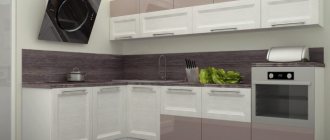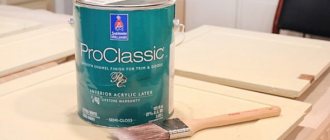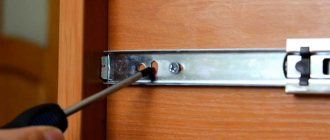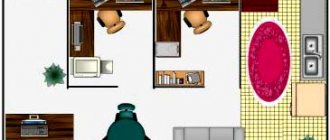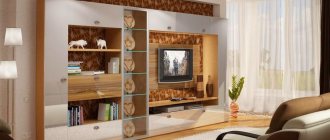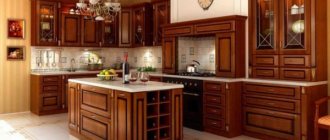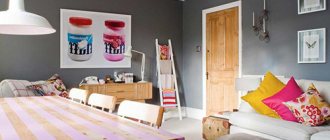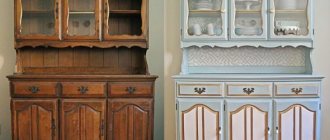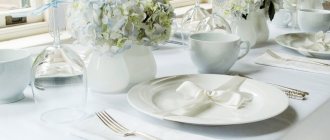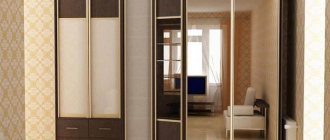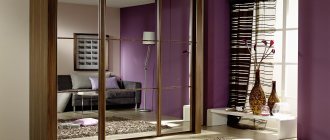Purchasing kitchen furniture is not cheap. Therefore, it is a shame when, after several years of operation, it loses its attractive appearance and problems appear in the functioning of its individual elements. It’s a shame to throw away old cabinets, bedside tables, tables and chairs, but buying new ones is expensive. Repairing kitchen furniture can not only extend the life of these items, but also significantly transform them, adding charm and originality.
Do it yourself or order furniture repairs at home?
Before you begin restoring kitchen furniture, you need to assess the amount of work and decide whether to do everything yourself or hire specialists.
Kitchen sets made from natural wood can be restored many times. Such furniture is not subject to significant deformation. Most often, wooden surfaces become covered with scratches, chips and abrasions during use. Eliminating these flaws with your own hands is possible even for a novice master.
It is more difficult with cabinet furniture made of MDF or chipboard with individual parts made of plastic, glass and metal. Remaking the body elements of bedside tables or cabinets that are swollen or have lost their geometry can be an overwhelming task, which means that the manufacture of new parts will have to be entrusted to specialists. But you can handle cosmetic repairs to the facade or countertop, adjusting or installing new hinges on the doors yourself.
Therefore, we have 2 ways:
- Carry out furniture repairs yourself. This option is suitable when you need to fix minor defects, you don’t need to make complex replacement parts, and also in a situation where you want to do without spending money. This path will allow you not only to save money, but also to bring your creative ideas to life.
- Contact a company offering furniture restoration services. This solution makes sense when damaged or lost-looking elements of the set cannot be repaired; a complete replacement of individual blocks, for example, facades and countertops, is required. In this case, you will have to spend money, but compared to buying new furniture, such a service will be inexpensive. The cost of replacing facades starts from 2200 rubles. per sq. m., countertops – from 4200 rub. per m.p.
During the repair process, it is useful to check and tighten all threaded connections: furniture assemblers often do not tighten them well enough, which leads to further loosening and distortion of the structure. And also lubricate all hinges and hinges to eliminate unpleasant creaking and ensure easy operation of these elements.
Eco style kitchen
The ideal option for such an update would be rattan fabric, offered in rolls or cut. The material is not cheap, but the look of the furniture is very impressive. Preparing for remodeling takes a little longer.
- The rattan fabric must be moistened with water and left for at least 30 minutes so that the material absorbs moisture. When rattan swells, it increases in volume, and when it dries, it stretches like a drum.
- You will need wooden slats with which you will need to hold and press the canvas to the sash. The slats are selected according to color and texture. The shade can be changed using stain or colored varnish.
- The facades are measured and the canvas is cut to size. A sash on which rattan occupies the central part looks more elegant, so the fragments are cut out somewhat smaller than the sash, and the planks are selected wider.
- The material is secured to the kitchen facades using a conventional stapler. The edges of the rattan insert are pressed with slats and secured with furniture nails - without heads. After updating, the sashes are installed in their places.
There are many methods for updating a kitchen set. Most of them do not require much expense at all, take very little time and are done with your own hands.
Door repair
A common defect in cabinet furniture is poor functioning of cabinet doors and bedside tables: they warp, do not want to close, and open spontaneously. The reasons are different: incorrect adjustment, defective hinges or magnetic latch, misalignment of the entire structure, swelling or delamination of the material.
Note: changes in the geometry of cabinets are often associated with the unsatisfactory condition of the back wall. The fiberboard sheet nailed there plays the role of a kind of retainer. If necessary, it is changed by cutting out the required fragment to size and attaching it with nails or small screws.
If the problem is in the loop, then replacing it is not always necessary: in most cases, adjustment helps. For this purpose, the design of the device has two screws: one is responsible for the fit of the door to the body, the second regulates its position in the frontal plane, moving it to the right or left.
A loop that has been torn out with meat can be put back in place using screws of a larger diameter. Another option is to drill holes, place wooden dowels in them using wood glue, and then screw fastening screws into them.
If the hinge breaks, it is replaced. Installation in old sockets is simple: mounting screws are screwed into the existing holes. It is more difficult if the hinge is installed in a new place or the door is changed. Assembly occurs in the following order:
- Sockets with a diameter of 35 mm for disc hinges are marked and cut with a milling cutter.
- A hinge plate is inserted into the slot located in the door perpendicular to the end and secured with a pair of self-tapping screws.
- The second plate is placed in the body, secured with screws through special holes in the bosses.
- Screw in the two adjusting screws to achieve the desired door position.
Details of adjusting the hinges are shown in the video.
Spontaneous opening of doors occurs when the magnetic strip is faulty. In some cases, it helps to clean the magnet and the iron plate it attracts from contamination, adjusting their relative position strictly opposite each other. If these measures do not help, then the element is changed.
And one more video: a little trick that will solve the problem of adjusting a cabinet with worn out hinges without replacing them.
We change accessories
To restore the functionality of the furniture, you should initially pay attention to the hinges, handles, and guides. The fittings may work properly, but the places where they are mounted often become loose, the material of the body and front panels crumbles, and the fastening loses its reliability.
This situation requires the relocation of door awnings or handles.
The work is carried out in several stages:
- dismantling old elements;
- marking holes in the selected mounting location;
- drilling holes;
- installation of fittings.
Old holes must be hidden under acrylic-based putty. As a result, the cabinets will again delight you with smooth doors and excellent workmanship.
Sanding wooden elements
In many apartments there is wooden furniture, often inherited from grandparents. In terms of workmanship and artistic value, it is superior to a cabinet one, but over many years of service, the surface becomes covered with numerous scratches, chips and stains. The easiest way to make cosmetic repairs is sanding.
You will need the following tools: a scraper, sandpaper or a sander. The technique of using the scrapers is not difficult: the scraper is held with both hands and progressively moved in the direction of the wood grain. The disadvantages of rough grinding are eliminated with fine sandpaper.
The restored surface is treated with a primer. It will protect the wood from moisture and ensure good adhesion to the varnish coating. The varnish will add shine to the furniture and protect against the appearance of mold or mildew stains. It is applied similarly to paint, using a brush.
Coloring
Restoration of solid wood facades can be carried out by using coloring compounds. Some craftsmen recommend using auto enamel, which is not afraid of moisture, high temperatures, or acidic cleaning agents.
The procedure takes place in several stages:
- dismantling the facade: the door is removed from its hinges, the glass inserts are removed or temporarily sealed, and the fittings are unscrewed;
- the surface is sanded with sandpaper;
- The entire part is coated with a special primer for wood processing in 2 layers;
- Proceed directly to painting using a brush or roller.
Restoration of home kitchen furniture made from natural solid wood requires subsequent varnishing. Using a brush, the transparent composition is evenly applied to the painted wood, making its color brighter. To achieve an aesthetic result, it is necessary to apply 3-4 layers of varnish, trying to make each top layer thinner than the bottom.
Cosmetic repair of cabinet furniture
Small chips, abrasions or scratches can be eliminated by simple manipulations:
- The edges of the chips are trimmed with a chisel, after which the damage is filled with wax. When it hardens, the excess material is removed, the surface is sanded and painted over with a suitable felt-tip pen or a special furniture marker. A varnish applied over the top will protect the restored area.
If possible, it is better to buy furniture wax of the desired shade, which will help disguise any defects on the furniture.
- The procedure for repairing scratches is similar: a layer of wax, sanding, painting, applying a varnish coating. When using colored furniture wax, coloring is not required.
- Scuffs are painted over using a soft cloth onto which dye is applied from a felt-tip pen.
- The cracks are filled with PVA glue using a syringe with a thin needle, and then tightened with clamps.
The following video shows how you can easily mask chips on furniture made of chipboard using furniture wax chalk.
And this video shows the technology for repairing large chips on the surface of a tabletop using an enamel felt-tip pen, super-hard wax and acrylic varnish.
Replacing the end edge
A common occurrence is a peeling end edge. Having found an edge that matches the color, prepare the tools necessary for repair: scissors, iron, painting knife. To smooth it you will need a roller or cloth.
- Cut the workpieces with allowances of 1–2 cm in length.
- With the tabletop facing up, apply the edge and smooth it with an iron. The heat will melt the glue.
- The glued workpiece is pressed to the end and smoothed with a cloth or a piece of felt, directing the movements along.
- Excess edges are removed using scissors and a carpenter's knife.
- The joints at the corners are sanded with fine sandpaper.
Facade repair
The front parts of kitchen units most often need updating. There are many options: restoration of the old coating, painting, using self-adhesive film, decoupage. If desired, you can give the furniture a completely new, unique and original look.
Options for restoration methods
Of course, replacement of functional elements (countertops, facades, showcases, aprons) should only be performed by a professional craftsman. You can independently restore the facades of kitchen furniture if necessary:
- replace fittings;
- paint and varnish natural wood;
- stick decorative stickers or film.
If you wish, you can create a real work of art from a typical bedside table, unremarkable cabinets, or boring drawers.
Repair with self-adhesive film
The self-adhesive film will give the headset a unique appearance.
Repairing facades using film is simple:
- The surface is prepared: the fittings are removed, the facade is sanded, degreased and primed.
- A piece of film is cut with an allowance of 2 cm on each side.
- The protective layer is removed from an area of 10–15 cm, the film is glued to the edge and at the same time smoothed with a piece of fabric.
- Next, gradually unwinding the roll, you need to fix the entire fragment on the facade, avoiding, if possible, the appearance of air bubbles.
- When pasting the ends and rounded areas, it is recommended to slightly heat the film with a hairdryer to make it more elastic.
- If it was not possible to avoid their formation, the bubbles are pierced with a needle or carefully cut to allow air to escape. All that remains is to smooth out the film.
- Excess material is carefully trimmed.
More details in the video.
The use of self-adhesive film during renovation often completely transforms kitchen furniture.
Modern style kitchen
I can’t show you how to update your kitchen units with your own hands in a photo, but they do allow you to see the result. Sometimes such updates look so amazing that they seem to be the result of the efforts of professionals. In fact, the secret lies in modern materials.
Vinyl decorative stickers are the simplest, most affordable, and perhaps the most effective method of turning any kitchen into something completely new. Often a self-adhesive film is used for this purpose (a layer of glue is already applied to its back surface). The design is very different: monochrome, with images, patterned, imitation of natural textures and even 3D images - there are a lot of options.
To give your headset a unique look, do this.
- Remove the sashes and remove the fittings. An additional advantage of this decoration method is that facades can be of any shape and size.
- The film is cut to the size of the facades. You should not do this without preliminary measurements, even if the dimensions of the headset are quite standard: during use, the dimensions have changed at least a little. When cutting, you need to take into account the coincidence of the boundaries of the images and the motifs of the ornament.
- The surface of the furniture is thoroughly wiped and degreased.
- Peel off 2-3 cm of protective paper and secure the adhesive side to the sash. Then, holding the film with one hand, the other gradually unfastens the paper and presses the film. Smooth out with a spatula if necessary.
- They install the fittings (preferably new) and put the facades in place.
Fashionable trends today - facades with different designs allow you to combine single-color doors and doors with images or patterns. This technique is very effective when it is necessary to change the proportions of a room and is readily used by professional designers.
Removing old film from furniture
A small peeling of the old self-adhesive film can be eliminated using PVA glue. The hardest part is getting to every hard-to-reach place.
But with large-scale damage you will have to do something radical: remove the film layer completely. This is done as follows:
- All fittings are removed. For convenience, it is worth dismantling the facade parts and working with them in comfortable conditions.
- The film is heated with a hair dryer, then removed with gloved hands.
- The surface is cleaned of glue residues, degreased, and then ready for further finishing: gluing a new layer of film or painting.
Furniture painting
It is often easier to paint the facade than to restore the old varnish coating. At the same time, you can radically change the design of your kitchen.
Proper painting includes the following operations:
- Disassembling the headset: removing fittings, hinges and drawers.
- Surface preparation: cleaning from dirt, grinding, removing dust, degreasing, priming. The latter is performed several times with breaks of 6–8 hours: this will reliably protect the material from external influences and ensure high paint adhesion.
If you plan to paint in different colors, the part of the surface on which a different shade will be applied is covered with masking tape. The same applies to elements that need to be protected from paint during the repair process.
It is best to paint using aerosol cans or a spray gun: this way it is easier to ensure uniform color and no streaks from a brush or marks from a roller will be visible.
Decoupage
This technique is a kind of appliqué made from various materials. Most often they use drawings cut out from napkins or magazines.
It is recommended to layer the paper so that the applique protrudes less above the general level of the facade. The further algorithm of actions is as follows:
- We prepare the surface: remove handles and other fittings, clean the paintwork, sand and repair defects.
- To achieve transparency of the varnish layer, mix white acrylic varnish and white paint.
- We paint the background in the direction of the wood grain.
- We place the prepared pattern, cut out and thinned, symmetrically relative to the facade and cover it with a layer of PVA.
- After letting the glue dry, we treat the surface with fine sandpaper, after which we apply a transparent varnish composition.
- After sanding the dried varnish, apply a new layer. And so on until the desired result is obtained.
A detailed master class on decoupage of furniture from chipboard is in the next video.
Another option for decoupage is the formation of ornaments using putty:
- Mix PVA glue and oil putty until the consistency of thick sour cream.
- We make a stencil of the future design from thick paper or cardboard.
- We fix the stencil on the facade, then apply the prepared solution with a spatula.
- After drying, we sand the ornament and coat it with varnish: first transparent, and then matte.
Decoupage can transform the most unattractive furniture. There are a great many options for the materials and technologies used. It all depends on the imagination and artistic taste of the master.
Self-adhesive
Another way to make completely new kitchen furniture from old ones. Self-adhesive film is suitable for bases that do not have ornate patterns. Otherwise, the restoration will be complex and quite time-consuming.
How to properly stick the film if we are doing a complete restoration:
- remove the facades and unscrew the fittings;
- we clean all contaminants including grease; let the base dry;
- cut out a piece of film to the size of the part with a margin of 2-3 cm, depending on the thickness of the facade;
- We free a small section of the material from the protective bottom layer and apply it to the workpiece;
- straighten with a rubber spatula or rag, removing all bubbles; moving forward - we separate the bottom layer and smooth out the film;
- When the façade is pasted over, we proceed to the side sections;
- we cut the film at the junction of two edges at an angle of 45 degrees and wrap first one edge, and then the second, and cut off the protruding sections;
- At the end of the restoration, we put everything in place.
Restoration of countertops made of chipboard or wood
Areas of the tabletop that are swollen from moisture or chipped are quite easy to restore. The repair procedure will be as follows:
- Remove loose pieces of material.
- Thoroughly dry and sand the surface.
- Mix PVA glue with sawdust to form a thick mass.
- Fill the indentations with the resulting mixture, place the weight and leave for 24 hours.
- We apply a protective coating to the surface.
Restoring a burnt countertop
Such damage is not uncommon for the surface of kitchen cabinets and tables. Replacing the countertop is a radical measure, but you can try to do without it by eliminating the damage yourself.
- Using a pencil, outline the boundaries of the defect with an allowance of 2 cm onto the undamaged surface.
- We remove the burnt area of the chipboard. A router is used for this operation. They sequentially remove layers of material: first along the intended line to one depth, then using a longer cutter to remove the next layer. And so on until the defective material is completely removed. The result is a stepped depression that looks like a miniature diamond and coal mine.
- Using a router, we make teeth along the contour of the cutout for better adhesion of the patch material to the base. This will also help make the transition smoother.
- Fill the hole with wood putty. We cut off a piece of the required size, knead it with our hands until soft and carefully compact it into the cutout. You need to work quickly, as the putty dries in a matter of minutes.
- We remove excess material protruding beyond the plane of the tabletop with a tool with a smooth edge. Some craftsmen use an old plastic card for this. To speed up the process, use a milling cutter with special grinding attachments.
- We polish the smooth surface using GOI paste with a soft-coated nozzle. This will add shine to the patch.
- All that remains is to paint the area to be restored, repeating the color and texture of the main part of the tabletop.
Making a tile countertop
What to do if the countertop is swollen or warped from moisture? The easiest option is to replace it with a new one, but there is no guarantee that it will not share the fate of the old one. Tile coating is more reliable, and it is not difficult to carry out such modernization of a kitchen set.
Tile countertop Do-it-yourself tile countertop Kitchen table with a tiled surface Tabletop and backsplash made of the same tile
Work order:
- The basis of the new countertop is made up of sheets of expanded polystyrene, fixed with liquid nails.
- Protective elements are attached to the same composition. Metal skirting boards are best suited for these purposes: corner ones, connecting the surface of the tabletop and the wall, end and thin ones, serving as edging for the tiles.
- Tile adhesive is applied to the new base surface of the countertop.
- The tiles are being laid out. Its height should correspond to the thin baseboards around the perimeter of the tabletop.
- After the glue has dried, the joints are grouted. It is recommended to use silicone-based waterproof compounds. This will prevent moisture from entering the structure.
The result is a smooth and durable surface that is not afraid of water.
Interesting ideas
When updating, other methods of decoration are additionally used. They are often combined with the options above :
- Painting . The painting on the doors of the kitchen unit looks beautiful. Designers often create real artistic masterpieces on furniture. You don't have to have artistic talent to decorate your kitchen with paintings. There are many stencils sold in specialty stores.
- Stickers . This is the simplest option for decorating a headset. It looks stylish and unusual. Such decorations are sold in furniture stores and departments of decorative goods. The picture is glued using the same principle as polymer film.
- Mosaic . It is attached to putty or liquid nails. It is recommended to make a wooden frame around such a fragment. The mosaic itself is made from tiles and even broken dishes.
- Panel . In this case, the doors are decorated with stones, dry plants, shells and any other objects suitable for the interior. They are pressed into plaster, which is first applied to the door in a thick layer. The composition is coated with varnish.
Chair repair
Damaged coverings of old kitchen chairs can be restored using the above methods. The exception is furniture with soft seats: re-upholstering them without skill is quite problematic, although possible. But there is a simple option: make a cover. In this case, reupholstery will not be required, and the appearance problem will be solved.
Loose parts are strengthened using wood glue. In exceptional cases, self-tapping screws are used with mandatory drilling of holes for them. Painting and decoupage transform an old, unsightly chair into an original and beautiful piece of furniture.
You should not throw away old kitchen furniture that has lost its outer luster. With a little imagination, you can give it a completely new appearance, adding originality to the interior of your home.
